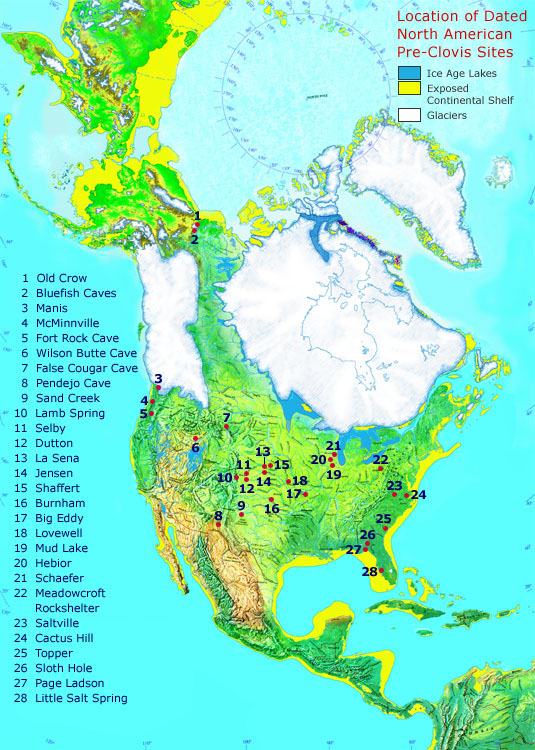|

|
| White areas are glaciers of the Ice Age |
|
1.
Old Crow
Yukon Territory
25,000-40,000
years old
Large mammal bones, possibly flaked or cut.
2. Blue Fish Cavesves
12,000-28,000 years old
Mammoth bone core
and flakes, microblades, and debitage.
3.
Manis
Washington
14,000
years old
Antler point in mastodon rib. Mastodon bone cut and flaked.
4.
McMinnville
Oregon
46,000 years old
Broken mammoth bones and bison tibia
chopper.
5.
Fort Rock Cave
Oregon
15,500 years old
Stemmed points found
in early context.
6. Wilson Butte Cave
Idaho
17,500-18,500 years old
Modified bones
and flakes.
7.
False Cougar Cave
Montana
12,500-17,500
years old
Stone artifacts and human hair.
8. Pendejo Cave
New Mexico
14,000 years old
Human hair and prints in
baked clay, and possible stone tools.
9.
Sand Creek
Texas
16,540 years old
Mammoth associated with a stone tool.
10. Lamb Spring
Colorado
13,500-15,000 years old
Flaked mammoth
bones.
11.
Selby
Colorado
14,000-17,000 years old
Flaked and polished extinct
mammal bones.
12.
Dutton
Colorado
14,000-17,000 years old
Flaked and polished extinct
mammal bones.
13.
La Sena
Nebraska
17,000-22,000 years old
Human-flaked mammoth bone.
14.
Jensen
Nebraska
17,000-22,000 years old
Human-flaked mammoth bone. |
|
15.
Shaffert
Nebraska
17,000-22,000 years old
Human-flaked mammoth bone.
16.
Burnham
Oklahoma
22,000-40,000 years old
Flake tools associated with
extinct fauna.
17.
Big Eddy
Missouri
14,000-14,500
years old
Possible stone tools.
18.
Lovewell
Kansas
22,000 years old
Modified mammoth bones.
19.
Mud Lake
Wisconsin
15,000-16,500
years old
Mammoth bones with butchering marks.
20.
Hebior
Wisconsin
15,000-16,500
years old
Stone tools and mammoth bones with butchering marks.
21.
Schaefer
Wisconsin
15,000-16,500
years old
Stone tools and mammoth bones with butchering marks.
22.
Meadowcroft
Pennsylvania
13,500-17,500 years old
Lanceolate point, blade-like
flakes, and charred basketry.
23.
Saltville
Virginia
15,000-16,000 years old
Flaked stone, fractured and
polished bone.
24. Cactus Hill
Virginia
17,000-19,000 years old
Lanceolate points, blades, and blade cores.
25.
Topper
South Carolina
15,000-16,000 years old
Possible stone tools found
in dated deposits.
26.
Sloth Hole
Florida
14,400 years old
Stone tools and cut mastodon tusks.
27.
Page Ladson
Florida
14,400 years old
Stone tools and cut mastodon tusks.
28.
Little
Salt Spring
Florida
14,000
years old
Shaped wooden stake embedded in extinct tortoise shell. |
Not shown:
Monte Verde
Chile
14,500
years old
Many organic artifacts, stone tools, and house structures
http://www.pbs.org/wgbh/nova/stoneage/fenn.html (see spear points here)
Even
faced with evidence to the contrary, Clovis First supporters refused to accept that people could have arrived in America earlier than 13,500 years ago.
When
Wallace and his team analyzed the mitochondrial DNA of Native Americans, they found four distinctive lineages that he labeled
A, B, C and D. All four turned out to share common ancestors back in Siberia and northeast Asia.
So far, these findings were consistent with the Clovis First theory that the first Americans came from Asia. But when Wallace calculated how long ago the Asian and Native American DNA diverged, he was shocked.
He repeated his work, as did other labs. The results were consistent. Three of the four main ancestral groups A, C and D,
diverged from their Asian forbears at least 20,000 years ago. And even more striking, the first Americans didn't all come
at once, but in at least three waves of migration.
Now consider the ,
The Clovis spear point is a single stone,
bifacial, or shaped on both sides, with a flute, or groove, at its base. The spear points in Asia
are made from lots of small razor-like flints called micro-blades embedded in a bone handle.
Now there was a real puzzle.
The DNA says the earliest Americans are from Asia, yet the Clovis point, is nowhere to be found in Asia.
One day, while making a Clovis point, he had a moment of inspiration. He remembered
a popular science book he had seen when he was a student. It showed pictures of ancient spearheads made by the Solutreans,
people who lived in Ice Age France and Spain.
Their spear points resembled Clovis points. It seemed unbelievable, but Stanford and Bradley
posed the question, "Could the Clovis point and some of the earliest Americans be from Europe?"
Overshot
flaking was an unusual technique that left behind a distinctive byproduct, big flakes, at ancient Clovis
stone working sites. Bradley wondered if traces of this technique might show up in southwestern France,
where the Solutreans had lived 20,000 years ago
NARRATOR: To connect the Solutreans and Clovis, he needed to find out if they produced their spearheads using the same big flake
technique.
BRUCE BRADLEY: So what we do is we go back to the collections of the broken materials, which is probably
99 percent of what there is here, and in that we're seeing the various ways that the Solutreans were making the things, not
just the finished objects. And so it's the pieces that are hidden away that are going to tell us the most.
NARRATOR:
And there in the drawers were big flakes, a clear sign that the Solutreans had made their spearheads in an identical technique
to that of Clovis.
My Additional Notes:
"Clovis" was the name given to this era because it was around Clovis,
New Mexico that artifacts of this era were first found. The Clovis era dates approximately 13,500 years ago. Clovis
artifacts were found in "Cactus Hill" Virginia. Excavating below this level, Pre-Clovis artifacts such as a
number of arrow points, blades, scrappers, and tool were found. This era is dated about 5,000 years before the Clovis
era, or about 18,000 years ago. This site is now closed and filled in. Other Pre-Clovis sites have been found
in Meadowcroft Rockshelter, Pennsylvania, and other locations.
A newer theory is that the people crossing over into what is now North
America, perhaps followed the western, warmer coastline in boats.
|
